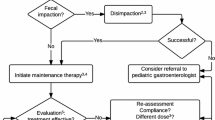Abstract
Constipation is a common problem in children, with childhood prevalence estimated at between 1 and 30%. It accounts for a significant percentage of referrals to paediatricians and paediatric gastroenterologists. It commonly runs in families, suggesting either an underlying genetic predisposition or common environmental factors, such as dietary exposure. The peak age for presentation of constipation is shortly after toilet training, when passage of hard stools can cause pain on defecation, which then triggers holding-on behaviour in the child. At the time of the next call to stool the toddler may try to prevent defecation by contraction of the pelvic floor muscles and anal sphincter. Unless the holding-on behaviour is quickly corrected by interventions to soften faeces and prevent further pain, the constipation can very rapidly become severe and chronic. Until recently, this mechanism was thought to be the only significant primary cause of constipation in childhood. In this review, we will summarise recent evidence to suggest that severe chronic constipation in children may also be due to slowed colonic transit.
Similar content being viewed by others
References
van den Berg MM, Benninga MA, Di Lorenzo C (2006) Epidemiology of childhood constipation: a systematic review. Am J Gastroenterol 101:2401–2409. doi:10.1111/j.1572-0241.2006.00771.x
Southwell BR, King SK, Hutson JM (2005) Chronic constipation in children: organic disorders are a major cause. J Paediatr Child Health 41:1–15. doi:10.1111/j.1440-1754.2005.00527.x
Catto-Smith AG (2005) 5. Constipation and toileting issues in children. Med J Aust 182(5):242–246
Talley NJ (2007) Functional gastrointestinal disorders in 2007 and Rome III: something new, something borrowed, something objective. Rev Gastroenterol Disord 7(2):97–105
Taminiau J, Benninga M (2005) Pediatric clinical research will benefit from Rome III. J Pediatr Gastroenterol Nutr 41(Suppl 1):S30–S31. doi:10.1097/01.scs.0000180295.12354.f7
Shin YM, Southwell BR, Stanton MP, Hutson JM (2002) Signs and symptoms of slow-transit constipation versus functional retention. J Pediatr Surg 37:1762–1765. doi:10.1053/jpsu.2002.36716
Sanjay J, Naughton CK, Yang M, Strickland A et al (2004) Mice expressing a dominant-negative Ret mutation phenocopy human Hirschsprung disease and delineate a direct role of Ret in spermatogenesis. Development 131:5503–5513. doi:10.1242/dev.01421
Puri P, Shinkai T (2004) Pathogenesis of Hirschsprung’s disease and its variants: recent progress. Semin Pediatr Surg 13(1):18–24. doi:10.1053/j.sempedsurg.2003.09.004
Benninga MA, Buller HA, Tytgat GN, Akkermans LM, Bossuyt PM, Taminiau JA (1996) Colonic transit time in constipated children: does pediatric slow-transit constipation exist? J Pediatr Gastroenterol Nutr 23:241–251. doi:10.1097/00005176-199610000-00007
Hutson JM, Chow CW, Borg J (1996) Intractable constipation with a decrease in Substance P-immunoreactive fibres: is it a variant of intestinal neuronal dysplasia? J Pediatr Surg 31:580–583. doi:10.1016/S0022-3468(96)90501-1
Cook BJ, Lim E, Cook D, Hughes J, Chow CW, Stanton MP, Bidarkar SS, Southwell BR, Hutson JM (2005) Radionuclear transit to assess sites of delay in large bowel transit in children with chronic idiopathic constipation. J Pediatr Surg 40:478–483. doi:10.1016/j.jpedsurg.2004.11.029
Milla P, Cucchiara S, DiLorenzo C, Rivera NM, Rudolph C, Tomomasa T (2002) Motility disorders in childhood: working group report of the First World Congress of Pediatric Gastroenterology, Hepatology, and Nutrition. J Pediatr Gastroenterol Nutr 35(Suppl 2):S187–S195. doi:10.1097/00005176-200208002-00017
van Ginkel R, Reitsma JB, Buller HA, van Wijk MP, Taminiau JA, Benninga MA (2003) Childhood constipation: longitudinal follow-up beyond puberty. Gastroenterology 125:357–363. doi:10.1016/S0016-5085(03)00888-6
DiLorenzo C, Hillemeier C, Hyman P et al (2002) Manometry studies in children: minimum standards for procedures. Neurogastroenterol Motil 14:411–420. doi:10.1046/j.1365-2982.2002.00347.x
Stanton MP, Hutson JM, Simpson D, Oliver MR, Southwell BR, Dinning P, Cook I, Catto-Smith AG (2005) Colonic manometry via appendicostomy shows reduced frequency, amplitude, and length of propagating sequences in children with slow-transit constipation. J Pediatr Surg 40:1138–1145. doi:10.1016/j.jpedsurg.2005.03.047
King SK, Catto-Smith AG, Stanton MP, Sutcliffe JR, Simpson D, Cook I, Dinning P, Hutson JM, Southwell BR (2008) 24-Hour colonic manometry in pediatric slow transit constipation shows significant reductions in antegrade propagation. Am J Gastrenterol 103:2083–2091
Hutson JM, Catto-Smith T, Gibb S, Chase J, Shin Y-M, Stanton M, King S, Sutcliffe J, Ong SY, Djaja S, Farmer P, Southwell B, Stephen L (2004) Gans lecture. Chronic constipation: no longer stuck characterisation of colonic dysmotility as a new disorder in children. J Pediatr Surg 39(6):795–799. doi:10.1016/j.jpedsurg.2004.02.003
Meier-Ruge W (1971) Casuistic of colon disorder with symptoms of Hirschsprung’s disease. Verh Dtsch Ges Pathol 55:506–510 (author’s translation)
Stanton MP, Shin YM, Hutson JM (2002) Laparoscopic placement of the Chait cecostomy device via appendicostomy. J Pediatr Surg 37:1766–1767. doi:10.1053/jpsu.2002.36717
Knowles CH, Martin JE (2000) Slow transit constipation: a model of human gut dysmotility. Review of possible aetiologies. Neurogastroenterol Motil 12:181–196. doi:10.1046/j.1365-2982.2000.00198.x
Wald A (2002) Slow transit constipation. Curr Treat Options Gastroenterol 5:279–283. doi:10.1007/s11938-002-0050-x
King SK, Sutcliffe JR, Southwell BR, Chait PG, Hutson JM (2005) The antegrade continence enema successfully treats idiopathic slow-transit constipation. J Pediatr Surg 40:1935–1940
Emmerson CA (1987) A preliminary study of the effect of interferential therapy on detrusor instability in patients with multiple sclerosis. Aust J Physiother 33:64–65
Chase J, Robertson J, Southwell B, Hutson JM, Gibb S (2005) A pilot study using transcutaneous electrical stimulation (interferential current) to treat chronic treatment-resistant constipation in children. J Gastroenterol Hepatol 20:1054–1061
Clarke MC, Chase J, Gibb S, Robertson V, Catto-Smith A, Hutson J, Southwell B (2009) Decreased colonic transit time following transcutaneous interferential electrical stimulation in children with slow transit constipation. J Ped Surg 44:408–412
Author information
Authors and Affiliations
Corresponding author
Rights and permissions
About this article
Cite this article
Hutson, J.M., Chase, J.W., Clarke, M.C.C. et al. Slow-transit constipation in children: our experience. Pediatr Surg Int 25, 403–406 (2009). https://doi.org/10.1007/s00383-009-2363-5
Accepted:
Published:
Issue Date:
DOI: https://doi.org/10.1007/s00383-009-2363-5




